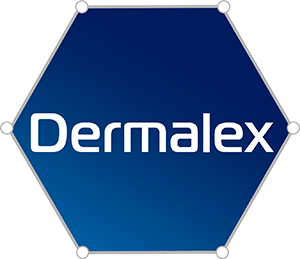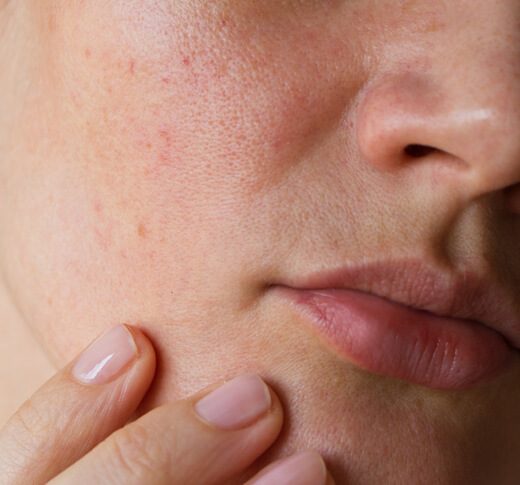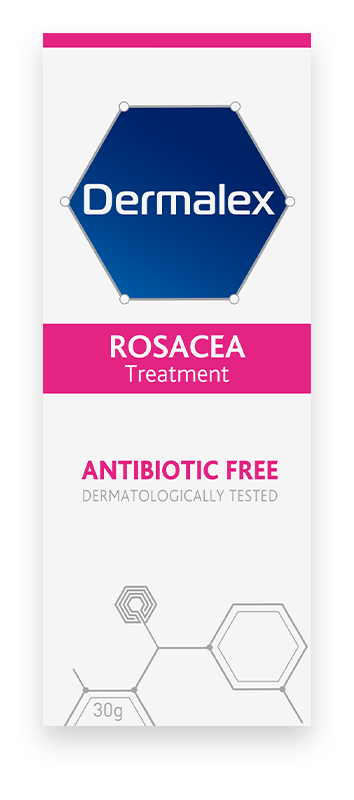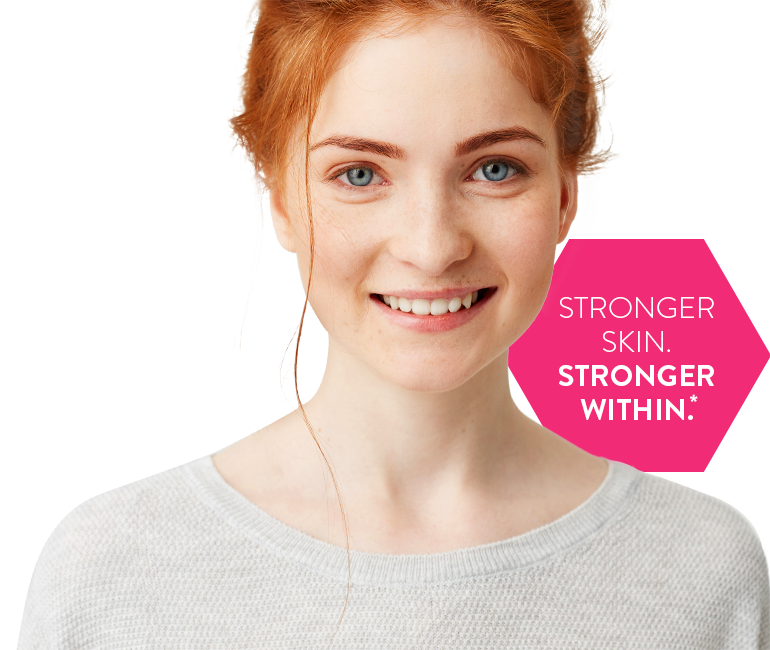
Rosacea
Rosacea is a common skin condition that causes redness, mostly in the face. While it’s perfectly treatable, we understand it can cause embarrassment, knock self-confidence - and just be plain irritating at times. Let’s take a look at causes, and what can be done about it.
What is Rosacea?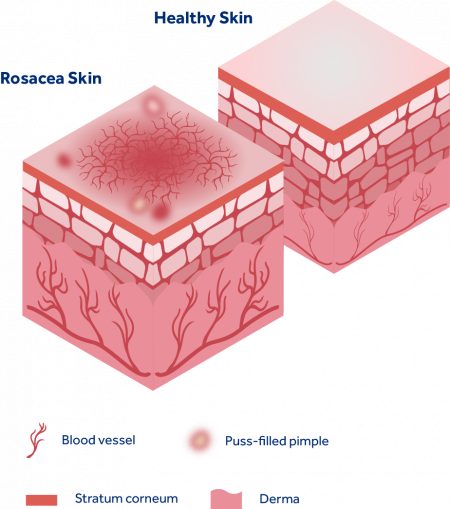
What is rosacea?
Rosacea gets its name from the Latin meaning of ‘rose-coloured’. It’s a common, chronic skin condition characterised by inflammation of the skin, causing reddening and flushing. It mainly affects the face, and is a long-term condition1.
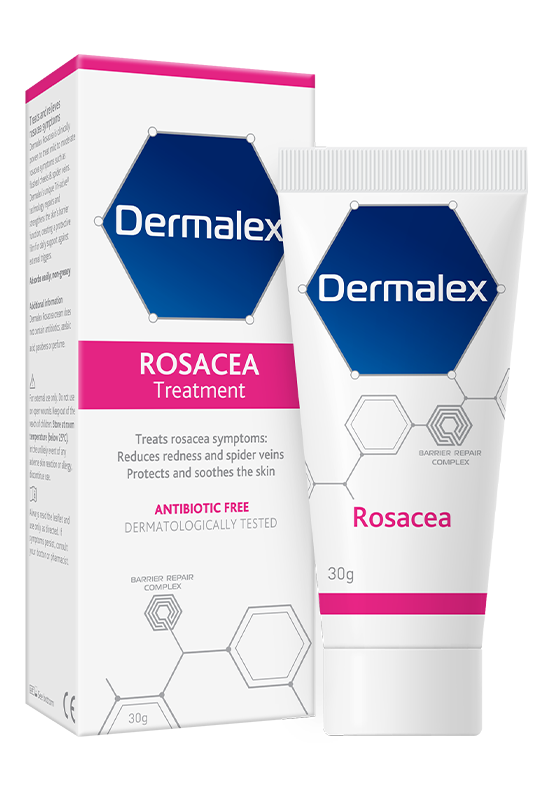
Causes & treatment
-
What does rosacea look like?
The main symptoms are redness and visible blood vessels, but it can also produce small, red, pus-filled bumps2.
- Flushing – often the earliest sign of the condition and can come and go
- Persistent redness – usually in the central part of the face e.g. nose and cheeks. Small blood vessels often swell and become visible
- Pimples – swollen, red bumps
- Hot and tender skin
- Thickened skin on the nose, causing it to appear bulbous (more common in men)
- Dry, rough skin
- Dry, irritated eyes and swollen eyelids
- Plaques – raised red patches, known as plaques, may develop without changes in the surrounding skin
Symptoms vary person to person; not all of those with the condition have every single one mentioned above. It can also affect other areas of the body, not just the face, most commonly the neck, chest, scalp or ears.
-
How long do symptoms last?
Rosacea sufferers have good days and bad days, given that flare-ups are erratic. They can flare up for weeks and then go away for a while – it depends on the individual.
-
Who suffers from rosacea?
Rosacea is a common skin condition: 10% of the world’s population suffers from it.
Around 1 in 600 people are diagnosed in the UK every year. Rosacea is most common among people over 30 who have fair skin. It normally starts around the age of 30 and affects 3x more women than men. It rarely affects children4. You’re also more likely to develop it if you have lighter skin.
-
Causes of rosacea
Experts are unsure what causes rosacea, however, there are contributing factors and triggers5.
Family history
As with many skin conditions, many people with a family history (e.g. a close relative) of the condition develop it. This might mean there’s a genetic component. However, just because a relative has it, doesn’t mean you’ll develop it.
Blood vessel abnormalities
What causes inflammation of the blood vessels is unknown, however, many specialists believe facial flushing is due to abnormalities in the blood vessels of the face.
Demodex folliculorum
Demodex folliculorum is a skin mite that lives on the skin and usually causes no problems, however, people with rosacea tend to have more of them. However, it’s unclear whether the mites cause rosacea – or the rosacea causes the increase in mites.
Helicobacter pylori
These gut bacteria stimulate the production of bradykinin. Bradykinin is a small polypeptide that causes blood vessels to dilate, which may play a role in the development of rosacea.
Other
Certain factors make you more likely to develop the condition also, including:
- Having light skin, blonde hair and blue eyes
- Being between 30-50
- Had severe acne
- Smoking6
-
Rosacea triggers
In some people, certain factors, such as diet, play a role7 in rosacea and can trigger or worsen symptoms. These include:
- Hot foods and beverages
- Spicy food
- Caffeine
- Alcohol
- Hot temperatures
- Sun exposure
- Stress, anxiety, embarrassment
- Hot baths
- Foods containing cinnamaldehyde, such as tomatoes
- Dairy products
- Vigorous exercise
- Certain medications
However, a lot of the evidence tends to be anecdotal; there’s a lack of research here.
-
How to get rid of rosacea
There isn’t a cure for rosacea. However, there’s plenty you can do to ease symptoms and help you manage them.
Self-care
Here are some things you yourself can do:
- Avoid rubbing or scrubbing your face
- Use a gentle, redness-reducing cleanser daily
- Avoid alcohol-based, perfumed products
- Blot your face dry, or let it dry naturally
- Wear an SPF of at least 30
- Wear a hat on sunny days
- Use an unperfumed moisturiser8
- Protect the face in cold weather e.g. with a scarf
- Use an electric shaver when shaving (these are less likely to trigger flare-ups)
Keeping a diary and recording any triggers you notice can also be a good idea.
Reduce stress
Stress can often trigger rosacea, so it’s a good idea to manage your stress levels where possible. This could be exercising daily, ensuring you get good quality sleep and eating a healthy diet.
Medicines
Some doctors may recommend the following medicines:
- Azelaic acid – to clear up bumps, swelling, and redness
- Metronidazole (Flagyl) and doxycycline – antibiotics that kill bacteria found on your skin
- Brimonidine (Mirvaso) – can help reduce redness by tightening blood vessels
Laser treatment, dermabrasion and using electric currents to zap damaged blood vessels can also be useful treatments.
-
How to prevent rosacea
There’s no foolproof method to prevent rosacea symptoms, but you can avoid the things that trigger flare-ups, like spicy food, hot drinks, stress and intense exercise. Where possible, try to avoid extreme temperatures – go inside when it gets too hot, for example.
Make sure to use daily sun protection, as exposure to the sun is a common trigger of rosacea.
Rosacea is a dry skin condition, so we strongly advise that you use an appropriate moisturising cream on your face. Avoid cosmetic products that contain alcohol or perfumes, and use soaps and shower gels that don’t dehydrate your skin.
You can use make-up to help cover any patches of persistently red skin. If your condition is more severe, it is best to consult your doctor or pharmacist.
As with all skin conditions, a healthy diet, enough sleep and regular gentle exercise can help improve the symptoms of rosacea.
-
How Dermalex helps
We’re here to help. The Dermalex range of creams has been specially formulated to moisturise and protect your skin, keeping your natural barrier strong and healthy. Each product in the range has been developed with a thorough understanding of the factors that lead to common skin conditions and clinically-proven to treat mild to moderate rosacea symptoms.
How can Dermalex help
Rosacea is an extremely common condition – and it can be treated. Good news, Dermalex has helped many sufferers soothe their skin. 95% noticed a reduction in redness9, as Dermalex is clinically proven to treat mild to moderate rosacea symptoms, including reducing redness and spider veins. It also protects the skin.
